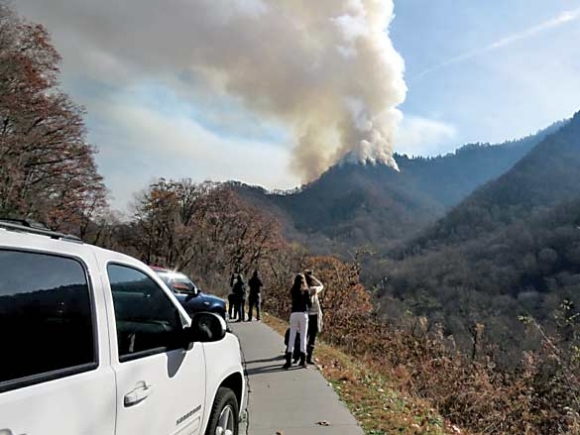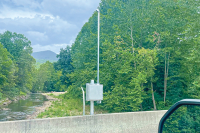The Chimney Tops 2 timeline

The fire review process included a thorough analysis of all communications and decisions made from the time the fire began on Nov. 23, 2016, to the time it left the Great Smoky Mountains National Park at 6 p.m. Nov. 28. According to the review team, here’s how it unfolded.
Wednesday, Nov. 23
5 p.m.: While responding to a call about a possible vehicle fire, the fire management officer and a park firefighter notice a smoke column rising from the Chimney Tops. The two climb the 2-mile trail to investigate the fire, estimated at less than 1 acre, but the terrain is steep and night is falling. The fire management officer realizes he can’t safely do anything until sunrise. The trail is closed to the public and the firefighters hike out.
Thursday, Nov. 24
8 a.m.: The fire management officer returns to the scene with four other firefighters. They see that the area is nearly vertical with unstable ground, making a direct fire line impossible. The fire management officer develops a strategy to hold the fire, now roughly 2 acres, to a 400-acre box. Crews begin scouting locations to build lines.
Friday, Nov. 25
It’s a foggy day at the Chimney Tops. Six staff members spend the day scouting for locations to build containment lines. The area’s rugged topography leaves few suitable areas, and no line is constructed.
Saturday, Nov. 26
3 a.m.: Due to high winds expected Nov. 28, a hazardous weather outlook is issued.
8 a.m.: Eight Park Service firefighters are working the fire. They split up to scout various areas for drainages and trails that would be suitable as fire containment lines.
Related Items
10:30 a.m.: The fire, estimated at 6-8 acres, has an inverted cloud layer below it with frost on the remaining vegetation and a wet hoar frost around Chimney Tops 2. The fire is burning slightly to the south and along the east sides of Chimney Tops 2 and Chimney Tops 1.
Noon: The morning inversion layer lifts, but fire behavior doesn’t change. The fire management officer still believes firefighters could catch and hold the fire in the drainage bottoms. Crews continue scouting for fire line locations, but report that downed trees, steep terrain and high brush would make fire line construction difficult with the people available.
5 p.m. Firefighters leave the Chimney Tops, and the fire management officer briefs the deputy park superintendent and chief ranger via text on actions taken and plans for the next day.
Sunday, Nov. 27
7:30 a.m. The fire management officer arrives at work and heads for the Chimney Tops at 8 a.m., estimating fire size at 10 acres. He sees that fire activity increased overnight and decides the response needs to be more proactive.
11 a.m. Staff firefighters return to the fire to provide additional information while the fire management officer remains in the office to order air and ground fire resources. These include three helicopters, fixed-wing aircraft, two Bureau of Indian Affairs engines with three crewmembers each, one Park Service wildland fire module with seven to 10 crew members and a long-term fire behavior analyst. In addition, two more Smokies firefighters return to duty.
1 p.m. The first helicopter arrives at the park and begins making bucket drops. Remaining air resources arrive within the next few hours and get to work. Meanwhile, ground crews begin constructing handlines, focusing on the southwestern portion of the area.
2:45 p.m. Aerial mapping puts the fire at 35 acres.
3:30 p.m. Images indicate that the fire perimeter is near the southwestern line of the containment box. Air operations cease at 5:30 p.m. due to weather-related flight restrictions.
7 p.m. The wildland fire module arrives and goes to observe the fire from an overlook.
8:15 p.m. Fire crews are released for the night due to the fire management officer’s perception that the fire appeared quiet.
Monday, Nov. 28
7 a.m. The fire management officer arrives at work knowing that high winds are forecasted for later in the day. He plans to use firefighters and engines to establish containment lines using drainages and any other wet areas, also removing leaf litter from the surface as far up the mountain as possible. Air attacks are planned as well. However, he then gets a call that fire has sprung up at the Chimneys Picnic Area, beyond the planned containment line.
7:30 a.m. Park leaders arrive at the picnic area and see that the fire had moved “in a significant way” from the night before — it is now 250 to 300 acres. A spot fire is also found across Newfound Gap Road near Graham Creek. Park leaders decide to order a Type 2 Incident Management Team to take over the response. Four 20-person fire crews are also requested from the Tennessee Interagency Coordination Center. Though the fire management officer does not believe the fire will reach Gatlinburg, he contacts the Gatlinburg Fire Department with an update. Meanwhile, the remainder of park management is briefed on the developments, and crews use leaf blowers to create holding lines around the picnic area buildings. Spot fire size estimates are unreliable, ranging from 0.5 acres to more than 50 acres.
11 a.m. A spot fire is reported at the Twin Creeks Picnic Pavilion, about 1.5 miles from Gatlinburg city limits. The fire management officer asks that the Tennessee Division of Forestry dispatch two bulldozers to Mynatt Park, a Gatlinburg subdivision near Twin Creeks. The park asks for the Gatlinburg Fire Department’s help in responding, and most Park Service resources are pulled from the Chimney Tops Picnic Area to assist.
12:30 p.m. Park Service leaders meet with representatives from local government and emergency response at Mynatt Park to organize defense of the subdivision.
1:30 p.m. The fire management officer asks for additional resources, including air attacks. The Tennessee Interagency Coordination Center offers a Type 1 Incident Management Team, which could arrive by 6 p.m., compared to four or five days for the Type 2 team that had been ordered. Efforts to protect Mynatt Park begin, continuing through about 5:30 p.m. Winds are blowing in multiple directions but prevailing from the south. Fire resources that were supposed to help with efforts to protect Gatlinburg can’t make it over from Chimneys Picnic Area until much later due to fire spread and downed trees on the highway.
5 p.m. Park headquarters is evacuated as fire approaches.
6 p.m. The fire management officer learns that the fire had crossed Newfound Gap Road and was headed toward the Ski Mountain area. 911 logs show that structures in Gatlinburg began burning from multiple ignition points during this time.
After 6 p.m. The fire response is by no means over. Though the most active part of the fire is gone from the park, it has arrived in the homes and towns of Sevier County. Homes burn, people struggle to escape and firefighters scramble to respond until rain arrives Nov. 29 to quell the flames. Fourteen people die as a result of the fires.
Two teenagers are later charged with aggravated arson for allegedly starting the Chimney Tops 2 Fire that resulted in so much death and destruction, but charges are dropped when the multiple ignition points caused by the windstorm make it impossible to prove that the deaths in Gatlinburg were a direct result of their actions. The Smokies then submits a request that the U.S. Attorney’s Office bring federal charges for the destruction in the national park. That office would not comment on the status of the request.









